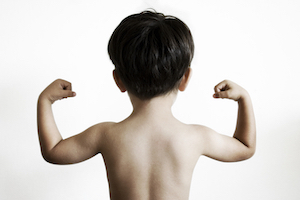
In a nutshell, resilience is the ability to cope with life’s experiences – the challenges and the failures. Children with resilience don’t necessarily have a problem free childhood, but they are able to work through the bad times, bounce back and thrive. Children who are resilient are shown to be happier, more academically and socially successful and have a lower risk of mental illnesses like depression. Some children develop resiliency independently – it’s just part of their personality – but most children learn from their experiences and environment during the early stages of childhood, where their personalities are still forming.
So what can a parent do to encourage resiliency? Experts suggest there are four main areas where children can be helped to develop these skills.
A child who is resilient has secure bonds with caring adults.
Give your child focused and meaningful attention. The old 80s adage of “quality time” still does hold some merit. So often, our lives are so busy, especially as our families grow, that is becomes hard to find this time. Is it any surprise that the stereotypical “baby of the family” seems to be the needy, attention-seeking adult?
Take time out to play with your child, and spend time with them in low-stimulation environments too – are you really spending “quality time” when you’re simply watching your child at a practice or lesson? Those experiences are important, but so is time spent in activities such as reading, gardening, playing sport or cooking together, where you and your child can really talk together.
Be your child’s soft place to land. So often, I’ve seen parents who tell their kids, especially their sons, to stop crying when someone has upset them. While it’s important not to catastrophise and over-do it, it’s also important to comfort your child’s emotional hurts, just as you would a physical one. Young children crave physical affection so a quick cuddle, and a chance to express their emotions is vital. Encourage your child to identify and express their feelings (“Are you feeling frustrated because you can’t climb the tree?”) and show empathy to their problems. Knowing they have support helps children to challenge themselves further next time.
A child who is resilient has positive role models.
No, this doesn’t mean you need to be a high-achiever in some recognised field, and it DEFINITELY doesn’t mean you need to look to celebrities for inspiration! One of the most effective things which you can do for your child is to model positive and resilient behaviours yourself. Look after your physical and mental health, be kind to others, demonstrate positive thinking and show your child that you use strategies to control your emotions too. Let go of the need to be “perfect” and let your child see that you also make mistakes that you have to recover from. Use humour to help your child see that failures are not the end of the world and show that it takes strength to seek support too.
A child who is resilient has opportunities to learn skills.
Just like a child needs to learn skills like feeding themselves and using the toilet, which we as adults find automatic, a child also needs to learn the skills of resilience. Teach your children about recognising their emotions and seeking strategies to cope. Deep breathing visualisations (“imagine your belly is a balloon: fill it up then relax and let it deflate” etc.) can be helpful and encourage them to verbalise negative thinking, then countering with positive self-talk. For instance, if my child sometimes comes home from school and says “No-one wants to play with me”, I can help her to draw out who does like to play with her and come to the conclusion that maybe no-one wanted to play with her today, but tomorrow they will, especially if she considers some strategies which we discuss.
Learning strategies such as the ability to make choices and persisting with practice are also skills to teach. Allowing your child to make safe decisions and then deal with their consequences encourages independence and responsibility. Set them up for success with step-by-step tasks which help them to develop the skill of breaking down daunting challenges to manageable ones. Encourage them to express gratitude and understand the importance of downtime.
A child who is resilient has opportunities to participate in meaningful activities.
Encourage your child to get involved, both within your household and in the wider community. Family responsibilities (we try to avoid calling them “chores” or “jobs”) encourage kids to see themselves as part of a whole, rather than as an isolated individual. Participating in family or cultural traditions also achieves this – invent some if they’re not already established (First Day of Summer Cookie Baking Madness is something my kids embraced with fervour and enthusiasm!).
Look for opportunities to get involved in your community. Whether it’s through churches, service groups (Rotary, Lions, SES, CFS) charities or council projects, volunteering your time and energy is a great way for children to learn, problem-solve, appreciate what they have and to build positive relationships with others. Sports and clubs like Scouts or Guides) also help foster these connections.
Being mindful of these opportunities and skills is a challenge for any parent’s already busy life. But encouraging resiliency in early childhood will have a surprisingly strong, positive impact on their entire life and help them cope with the good times and the bad. It’s definitely a path I’m choosing to take.













